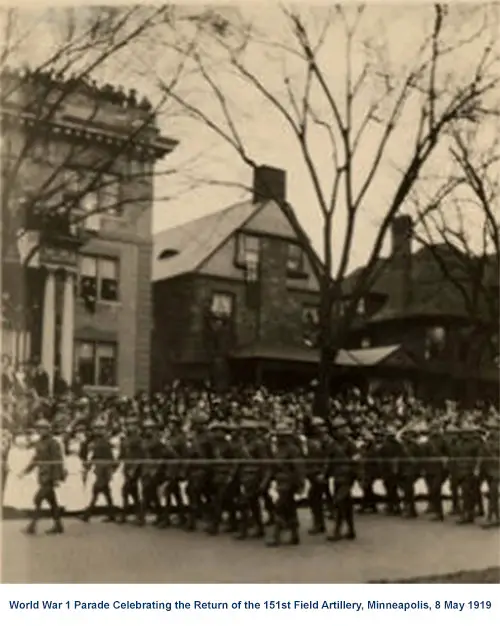History of Minnesota Bonus for Veterans of World War I

World War 1 Parade Celebrating the Return of Soldiers of the 151st Field Artillery on 8 May 1919 in Minneapolis, Minnesota. Minnesota Digital Library MHS11167. GGA Image ID # 18485ea746
Under the provisions of Chapter 49, Extra Session Laws 1919, the State of Minnesota provided relief and assistance for certain general classes of persons who served in the Armed Forces of the United States during World War I. Further provision was made for issuance of certificates of indebtedness for the raising of necessary funds therefor; for the retirement of the same by moneys raised from a tax levy provided therefor; the creation of a Board to issue such certificates and supervise the expenditure and disbursement of such funds; and appropriating the sum of $20,000,000 therefor.
Provisions of the Act
Under the term of this Act, Veterans of World War I who were bona fide residents of the State of Minnesota at time of entry into service and who held an honorable discharge received the sum of $15.00 per month for each and every month of service and fraction thereof, with the provision, however, that the amount received would be not less than $50.00. Initially no maximum was set but later on a termination date was fixed to coincide with the date on which peace was proclaimed by Resolution of Congress and thus the maximum bonus payment was limited to $600.00.
Conscientious Objectors Excluded
In the original Act, those individuals who at any time during the period of the war with Germany sought to evade service because of conscientious objection thereto or who had been guilty at any time of fraud or violation or evasion of the Selective Service Act or of the rules and regulations there under were prohibited from receiving the bonus. In subsequent sessions of the Legislature, the Act was amended again and again until, finally, many of the foregoing restrictions were lifted and the individuals were granted the bonus by Special Acts of the Legislature.
There was a further provision for the payment of bonuses to widows, minor children, the father or mother of the veteran who was killed or died during the war, but no such bonus was paid in the event the veteran died after discharge. This provision of law was later amended to pay a bonus to widows and orphans, fathers or mothers, as the case might be, irrespective of whether the soldier died while in service or died after being discharged.
Administration Made Difficult
As a result of the prohibitions against the payment of the bonus to certain individuals and the provisions relating to the payment of a bonus in other cases, the administering of the Act became very difficult and unduly costly. The average cost of processing a bonus claim of World War I approximated $5.00 per claim. This rather high cost was caused by the complications of the Act itself, by the necessity of maintaining a Washington Bureau in order to obtain World War I Army and Navy records and Selective Service Records which were not then available, and finally because of the many changes in the Act on the part of subsequent legislatures.
The prohibition against the payment of a bonus to aliens and alien objectors, conscientious objectors, and draft evaders made it necessary to check and photostat hundreds of thousands of Selective Service records. Not only did this add greatly to the cost of administration but it delayed substantially the payment of the bonus itself.
The situation was further complicated, and its execution delayed by the fact that under the provisions of Chapter 49, Extra Legislative Session 1919, interest on the bonds was set at 4%. The State was unable to sell the bonds at that rate of interest and no bonds were sold until the legislative session of 1921 raised the rate of interest to 6%.
Payments Delayed
Owing to the complications of the Act, the difficulty of administration and inability to sell bonds at 4% interest, no payments were made for a long period of time. Finally, arrangements were made with certain banks who purchased bonds at 4%, which permitted the banks to designate the payee.
This was not a good arrangement and led to much criticism. As a result of the haste to get claims in shape for payment, there was a lack of proper planning and, on the whole, the administration of the Bonus Act was highly inefficient, and it was inevitable that minor scandals would arise. With the passage of time these conditions were corrected and the sale of the bond payments was expedited.
Total Cost Was $28,000,000
A total $28,000,000 was paid out by the State of Minnesota for bonuses accruing as a result of service in World War I. Of this amount, $20,000,000 was raised through the sale of bonds and the remainder was appropriated from the General Revenues of the State during later years.
Spanish-American War Bonds
In 1931 the Legislature passed a Bonus Act to pay to veterans of the Spanish-American War a bonus of $15.00 a month for each month of service between April 12, 1898 and July 4, 1902 at the rate of $15.00 per month for every month of service or fraction thereof. This bonus covered service in the Spanish-American War, the Philippine Insurrection, and the Boxer Rebellion. Profiting by the mistakes inherent in the World War Bonus Act, the Spanish American War Bonus Act was much simplified and contained only two requirements for eligibility; that the individual be a bona fide resident of the State of Minnesota at time of entry into service and had received an honorable discharge.
Minnesota Institute of Governmental Research, “Appendix A: History of Bous for Veterans of World War I,” in Proposed Soldiers’ Bonus in Minnesota, Bulletin # 23, 23 July 1948, p. 13.
